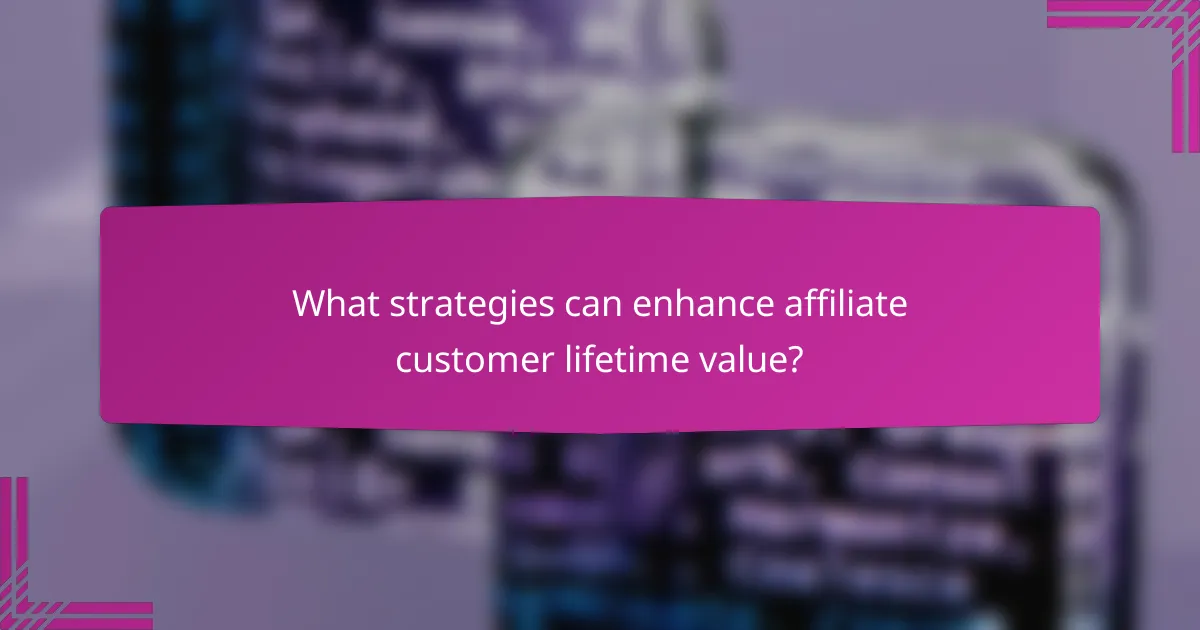Understanding affiliate customer lifetime value (CLV) is crucial for businesses aiming to maximize revenue from their customer relationships. By evaluating CLV, companies can assess the effectiveness of their affiliate marketing strategies and make informed decisions on customer acquisition spending. Utilizing key metrics allows for deeper insights into customer behavior, while targeted strategies can enhance long-term relationships and increase overall profitability.

How to evaluate affiliate customer lifetime value?
Evaluating affiliate customer lifetime value (CLV) involves understanding the total revenue a customer generates throughout their relationship with your brand. This metric helps businesses assess the effectiveness of their affiliate marketing strategies and optimize their spending on customer acquisition.
Definition of Customer Lifetime Value
Customer Lifetime Value (CLV) is the projected revenue that a customer will generate during their entire relationship with a business. It takes into account various factors, including purchase frequency, average order value, and customer retention rates. Understanding CLV allows businesses to make informed decisions about marketing investments and customer engagement strategies.
Importance of CLV in Affiliate Marketing
CLV is crucial in affiliate marketing as it helps determine the profitability of affiliate partnerships. By knowing the CLV, businesses can allocate budgets effectively, ensuring that they invest appropriately in affiliate commissions and marketing efforts. A higher CLV indicates that a customer is likely to generate more revenue, making them a valuable target for affiliates.
Additionally, understanding CLV can guide affiliates in selecting the right products to promote. Affiliates can focus on products with higher CLV, leading to better conversion rates and increased commissions.
Key Metrics for Evaluation
To evaluate CLV effectively, consider several key metrics: average order value (AOV), purchase frequency, and customer retention rate. AOV indicates how much a customer spends per transaction, while purchase frequency measures how often they buy. Customer retention rate reflects the percentage of customers who continue to engage with your brand over time.
Using these metrics, you can calculate CLV with the formula: CLV = AOV x Purchase Frequency x Customer Lifespan. This calculation provides a clearer picture of the long-term value of your customers.
Tools for CLV Calculation
Various tools can assist in calculating CLV, ranging from simple spreadsheets to advanced analytics platforms. Customer Relationship Management (CRM) systems like Salesforce or HubSpot often include built-in CLV calculators. These tools can automate data collection and provide insights into customer behavior.
Additionally, analytics platforms like Google Analytics can help track customer interactions and sales data, making it easier to estimate CLV. For more detailed analysis, consider specialized software like Kissmetrics or Mixpanel, which offer advanced metrics and reporting features.

What metrics are used to measure affiliate customer lifetime value?
To effectively measure affiliate customer lifetime value (CLV), several key metrics are utilized. These metrics provide insights into customer behavior and profitability, helping businesses optimize their affiliate strategies.
Average Order Value
Average Order Value (AOV) represents the average amount spent by customers per transaction. It is calculated by dividing total revenue by the number of orders. For example, if a business generates $10,000 from 200 orders, the AOV would be $50.
Understanding AOV helps businesses identify pricing strategies and product bundling opportunities. A higher AOV can significantly enhance overall CLV, making it crucial to monitor and improve this metric.
Purchase Frequency
Purchase Frequency measures how often a customer makes a purchase within a specific timeframe. This metric is calculated by dividing the total number of purchases by the number of unique customers. For instance, if 100 customers made 300 purchases in a year, the purchase frequency would be 3.
Increasing purchase frequency can lead to higher CLV, as repeat customers tend to spend more over time. Strategies such as loyalty programs or targeted marketing can effectively boost this metric.
Customer Retention Rate
Customer Retention Rate indicates the percentage of customers who continue to make purchases over a given period. It is calculated by taking the number of retained customers divided by the total number of customers at the start of the period, multiplied by 100. A retention rate of 70% means that 70 out of 100 customers return for repeat purchases.
A high retention rate is essential for maximizing CLV, as retaining existing customers is often more cost-effective than acquiring new ones. Implementing excellent customer service and engagement strategies can enhance retention rates.
Customer Acquisition Cost
Customer Acquisition Cost (CAC) is the total cost associated with acquiring a new customer, including marketing expenses, sales costs, and any other related expenditures. It is calculated by dividing total acquisition costs by the number of new customers gained during a specific period. For example, if a company spends $5,000 to acquire 100 new customers, the CAC would be $50.
Understanding CAC is vital for assessing the profitability of affiliate marketing efforts. Ideally, CLV should exceed CAC significantly to ensure sustainable growth. Businesses should regularly evaluate their acquisition strategies to optimize costs and improve overall profitability.

What strategies can enhance affiliate customer lifetime value?
Enhancing affiliate customer lifetime value (CLV) involves implementing targeted strategies that foster long-term relationships with customers. By focusing on personalized marketing, engagement, loyalty, and effective selling techniques, businesses can significantly increase the value derived from each customer over time.
Personalized Marketing Campaigns
Personalized marketing campaigns tailor messages and offers to individual customer preferences, which can greatly enhance CLV. Utilizing data analytics, businesses can segment their audience and create targeted promotions that resonate with specific groups, leading to higher conversion rates.
For example, sending personalized emails based on previous purchases can encourage repeat buying. A/B testing different approaches can also help determine which messages yield the best response rates.
Customer Engagement Techniques
Engaging customers through various channels is crucial for maintaining their interest and loyalty. Techniques such as interactive content, social media engagement, and regular communication can keep customers connected to the brand.
Consider hosting webinars or live Q&A sessions to foster community and provide value. Regularly soliciting feedback and responding promptly can also enhance customer satisfaction and retention.
Loyalty Programs
Loyalty programs incentivize repeat purchases by rewarding customers for their continued business. These programs can include points systems, exclusive discounts, or early access to new products, which encourage customers to return.
Implementing tiered rewards can motivate customers to increase their spending to reach higher levels of benefits. Ensure the program is easy to understand and accessible to maximize participation.
Upselling and Cross-selling
Upselling and cross-selling are effective strategies to increase the average order value and overall CLV. Upselling involves encouraging customers to purchase a more expensive version of a product, while cross-selling suggests complementary items.
For instance, if a customer buys a camera, recommending lenses or accessories can enhance their experience and increase sales. Training sales staff to recognize opportunities for these techniques can lead to significant revenue growth.

What are the prerequisites for effective CLV strategies?
Effective Customer Lifetime Value (CLV) strategies require a clear understanding of your target audience, robust data analytics capabilities, and the integration of marketing tools. These elements enable businesses to accurately assess customer value and tailor their marketing efforts accordingly.
Understanding Your Target Audience
To develop effective CLV strategies, it’s crucial to know who your target audience is. This involves segmenting customers based on demographics, purchasing behavior, and preferences. By understanding these factors, businesses can create personalized marketing campaigns that resonate with specific customer groups.
Consider using surveys or customer feedback tools to gather insights about your audience. This data can help identify trends and preferences, allowing for more targeted approaches that can enhance customer loyalty and increase lifetime value.
Data Analytics Capabilities
Strong data analytics capabilities are essential for measuring and predicting CLV. Businesses should invest in analytics tools that can track customer interactions, purchases, and engagement over time. This data helps in calculating CLV accurately and understanding the factors that influence it.
Utilize metrics such as average order value, purchase frequency, and retention rates to analyze customer behavior. Regularly reviewing these metrics can provide actionable insights that inform marketing strategies and improve customer retention efforts.
Integration of Marketing Tools
Integrating various marketing tools is vital for executing effective CLV strategies. This includes CRM systems, email marketing platforms, and social media management tools. A cohesive approach ensures that all customer touchpoints are aligned and that data flows seamlessly between systems.
Choose tools that offer compatibility and can share data in real-time. This integration allows for more effective tracking of customer journeys and enables timely adjustments to marketing strategies based on customer behavior and preferences.

How do affiliate programs impact customer lifetime value?
Affiliate programs can significantly enhance customer lifetime value (CLV) by driving targeted traffic and fostering customer loyalty. By leveraging partnerships, businesses can attract customers who are more likely to engage and make repeat purchases, ultimately increasing their overall value.
Commission Structures
Commission structures in affiliate programs directly influence how affiliates promote products and the resulting customer engagement. Common models include pay-per-sale, pay-per-click, and pay-per-lead, each offering different incentives that can affect an affiliate’s motivation and effectiveness. For instance, a pay-per-sale model may encourage affiliates to focus on high-quality leads that are more likely to convert into loyal customers.
When designing commission structures, consider offering tiered commissions that reward affiliates for higher sales volumes. This can motivate them to invest more effort into promoting your products, ultimately enhancing customer retention and increasing CLV.
Influencer Partnerships
Influencer partnerships can play a pivotal role in boosting customer lifetime value by tapping into established trust and credibility. Collaborating with influencers who align with your brand can attract a dedicated audience that is more likely to engage with your offerings. This can lead to higher conversion rates and repeat purchases as influencers often create authentic content that resonates with their followers.
To maximize the impact of influencer partnerships, choose influencers whose audience matches your target demographic. Monitor engagement metrics to assess the effectiveness of these collaborations and adjust your strategy accordingly to ensure sustained customer interest.
Product Quality and Reputation
The quality of products and the overall reputation of your brand are critical factors in determining customer lifetime value within affiliate programs. High-quality products lead to satisfied customers who are more likely to return and recommend your offerings to others. Conversely, poor product quality can damage your brand’s reputation and diminish CLV.
Regularly gather feedback from customers and affiliates to assess product quality and address any issues promptly. Building a strong brand reputation through excellent customer service and product reliability can significantly enhance the effectiveness of your affiliate program and increase customer loyalty over time.

What are the emerging trends in affiliate customer lifetime value?
Emerging trends in affiliate customer lifetime value (CLV) focus on personalization, data analytics, and multi-channel strategies. Businesses are increasingly leveraging technology to enhance customer experiences and optimize their affiliate marketing efforts.
Personalization in Affiliate Marketing
Personalization is becoming essential in affiliate marketing, as tailored experiences can significantly boost customer engagement and retention. By utilizing customer data, affiliates can create targeted campaigns that resonate with specific audience segments, leading to higher conversion rates.
For example, using behavioral data to recommend products based on past purchases can enhance customer satisfaction. This approach often results in increased average order values and repeat purchases, ultimately raising the CLV.
Data-Driven Decision Making
Data analytics is a key trend influencing affiliate CLV. By analyzing customer behavior and purchase patterns, businesses can make informed decisions that enhance marketing strategies. This includes identifying high-value customers and optimizing affiliate partnerships based on performance metrics.
Utilizing tools like Google Analytics or affiliate tracking software can provide insights into which affiliates drive the most valuable customers. This information allows for better allocation of resources and improved campaign effectiveness.
Multi-Channel Affiliate Strategies
Multi-channel strategies are increasingly important for maximizing affiliate CLV. Engaging customers across various platforms—such as social media, email, and websites—can create a cohesive brand experience that encourages loyalty. Each channel can serve different purposes, from brand awareness to direct sales.
For instance, combining social media promotions with email marketing can reinforce messages and drive traffic to affiliate offers. This integrated approach helps to maintain customer interest and can lead to higher lifetime values as customers interact with the brand through multiple touchpoints.
